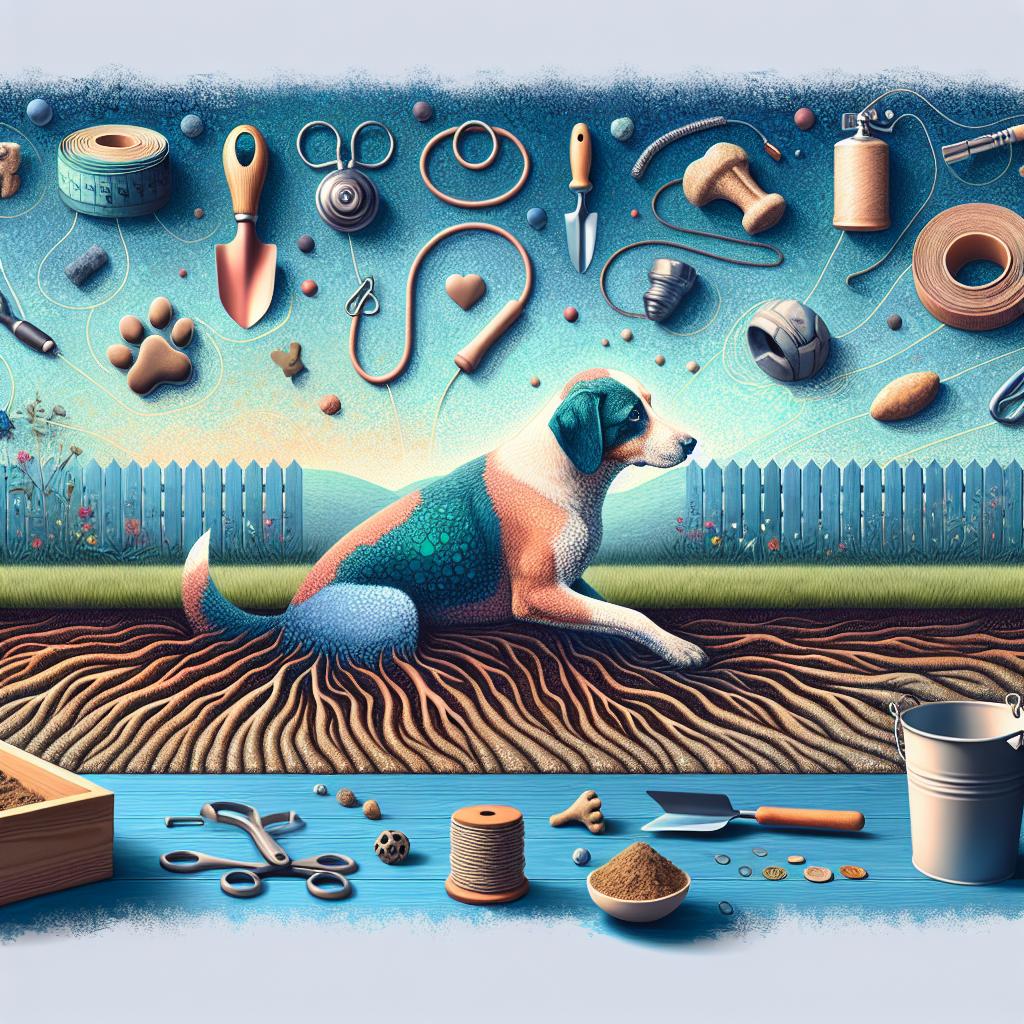Title: How to Stop Your Dog from Digging: Training Tips
Introduction:
For many dog owners, the sight of their furry companion engaging in an enthusiastic excavation mission can evoke a blend of amusement and exasperation. Whether it’s an innocent quest for buried treasures or a determined effort to create a new landscape in your yard, digging can quickly become a perplexing challenge. While some breeds may have a natural proclivity for digging, the behavior can stem from various motivations—boredom, anxiety, or simply an urge to explore. In this article, we’ll uncover effective training tips to help curb this instinctive yet often disruptive behavior. With a bit of patience and understanding, you can redirect your dog’s energy and foster a harmonious relationship that leaves both of you happy and your garden intact. Let’s dig into the solutions!
Understanding the Root Causes of Digging Behavior
Digging behavior in dogs can often be attributed to several underlying reasons, which vary from one animal to another. Understanding these root causes is crucial for developing an effective training strategy. Some common motivations for this behavior include:
- Boredom: Dogs that lack physical and mental stimulation may dig as a way to entertain themselves.
- Instinct: Certain breeds are predisposed to digging due to their genetic background, particularly those used for hunting or burrowing.
- Seeking Comfort: Dogs may dig to create a cozy spot or to find cooler ground during hot weather.
- Attention-Seeking: If dogs notice that digging gets them attention from their owners, they may repeat the behavior to elicit a response.
Moreover, environmental factors can play a significant role in a dog’s digging habits. Here are a few examples of what might contribute to this behavior:
| Environmental Factor | Description |
|---|---|
| New Surroundings | Moving to a new home can cause anxiety, leading dogs to dig as a coping mechanism. |
| Presence of Wildlife | Dogs may dig to explore scents left by other animals or to chase after critters buried underground. |
| Unfamiliar Sounds | Loud noises can trigger digging as dogs attempt to escape or seek shelter from perceived threats. |

Effective Training Techniques to Redirect Your Dogs Energy
Redirecting your dog’s energy is crucial in curbing unwanted digging behavior. High-energy dogs often dig out of boredom or excess energy, so providing them with appropriate outlets can mitigate this tendency. Consider introducing a stimulating exercise routine that incorporates both physical and mental activity. Activities such as:
- Daily walks that increase in duration over time
- Interactive playtime using toys that encourage fetching and tugging
- Obstacle courses set up in the yard to challenge them physically and mentally
In addition to physical activities, incorporate mental challenges into their daily routine. Offering puzzle toys or engaging in training sessions that focus on obedience and tricks can provide the necessary mental stimulation to keep your dog occupied. Consider using a combination of:
- Clicker training to reward positive behaviors
- Scent work games that encourage them to use their noses
- Socialization opportunities with other dogs to burn off energy
Combining physical exercise with mental challenges not only helps redirect your dog’s energy but also strengthens your bond with them. Always keep their favorite toys handy to redirect their attention when they begin to dig, reinforcing alternative behaviors that are more acceptable.

Creating a Dig-Friendly Space: Alternatives to Consider
Transforming your outdoor space into a dig-friendly environment can help redirect your dog’s natural instincts while preserving your garden and yard. Consider implementing designated digging areas using materials like sandboxes, soil pits, or even a small patch of loose gravel. You can enhance the appeal of these areas by burying toys, treats, or even your dog’s favorite bones—this not only entices them to dig in the right spot but also provides mental stimulation. Additionally, ensure these spaces are easily accessible and well-marked, possibly with colorful flags or signage, to guide your dog to their digging haven.
Another method is to introduce interactive elements, such as a digging toy or sensory mat, that encourages your furry friend to engage with their surroundings creatively. You might also explore planting dog-friendly shrubs or grasses in designated areas. Not only do these plants serve as natural barriers for unwanted digging, but they can also foster a sense of exploration. Consider creating a small garden table to showcase some safe, edible plants like mint or parsley, making your dog a part of your gardening experience while keeping them entertained.

Building a Stronger Bond Through Positive Reinforcement
Building a connection with your dog through positive reinforcement can lead to a more secure and trusting relationship. When your furry friend digs inappropriately, instead of scolding them, redirect their energy towards acceptable activities and reward them for good behavior. This approach encourages them to associate positive actions with praise and treats. Consider applying the following techniques:
- Reward Ideal Behavior: Whenever your dog plays in a designated spot instead of digging, offer treats and affectionate words.
- Create a Digging Zone: Establish a specific area for digging; use it to channel their natural instincts. When they dig there, reward them!
- Use a Clicker: Incorporate a clicker to mark positive behaviors. The sound signals to your dog that they’ve done something right, enhancing their learning.
Establishing clear and consistent commands also plays a vital role in this bonding process. Communicating effectively helps your dog understand what you expect, creating a cooperative environment. Utilize simple commands paired with rewards to reinforce their understanding. Here’s a glimpse into how to structure this method:
| Command | Action | Reward |
|---|---|---|
| Leave it | Redirect from digging | Treat & Praise |
| Go to your spot | Lead to a designated area | Treat & Playtime |
| Stay | Hold position near you | Affection & Treats |
Q&A
Q&A: How to Stop Your Dog from Digging: Training Tips
Q1: Why do dogs dig in the first place?
A: Dogs dig for various reasons, including boredom, anxiety, instinctual behavior, or because they’re trying to escape. Sometimes, they’re even seeking comfort or coolness! Understanding the motive behind your pup’s digging can help you address the specific issue more effectively.
Q2: What are the signs that my dog is digging out of boredom?
A: If your dog is digging obsessively in a specific area, or if the digging occurs alongside other signs like excessive barking, chewing, or restlessness, boredom might be the culprit. Providing regular exercise and mental stimulation can help curb this behavior.
Q3: Are there specific training techniques I can employ to stop my dog from digging?
A: Absolutely! Here are a few effective techniques:
- Redirection: When you catch your dog digging, redirect their attention to a toy or a game. This establishes a more appropriate outlet for their energy.
- Command Training: Teach basic commands like “leave it” or “no.” Use these commands when you see your dog starting to dig.
- Create a Digging Spot: Designate a specific area where your dog is allowed to dig, and train them to use it. This can satisfy their natural instincts in a controlled way.
Q4: How can I keep my dog’s environment engaging to prevent digging?
A: Keeping your dog’s environment stimulating can significantly reduce unwanted digging. Incorporate interactive toys, puzzles, and regular play sessions. Consider introducing scent trails or agility courses to challenge their minds and bodies.
Q5: Is it helpful to use deterrents for digging?
A: Yes! You can use both physical barriers and natural deterrents. For instance, sprinkling cayenne pepper or placing thorny branches in problematic digging spots can discourage your dog. However, ensure that any method is safe and humane; the goal is to redirect rather than punish.
Q6: How should I react when I catch my dog digging?
A: Your reaction is crucial! Instead of scolding your dog, calmly redirect them to a more appropriate activity. If they stop digging, offer praise. Positive reinforcement is more effective than negative reactions in promoting good behavior.
Q7: When might I need professional help to stop my dog from digging?
A: If your dog’s digging is excessive or linked to anxiety, it may be time to seek professional help. A certified dog trainer or behaviorist can provide personalized guidance and strategies tailored to your dog’s specific needs.
Q8: Can digging be a sign of health issues?
A: Yes, in some cases, excessive digging might indicate health problems, such as allergies or discomfort. If you notice that your dog is digging more than usual, it’s a good idea to consult a veterinarian to rule out any underlying health concerns.
Q9: How long does it typically take to stop my dog from digging?
A: Every dog is unique, and the time it takes to curb digging can vary. With consistent training, redirection, and engagement, many owners see significant improvements within a few weeks. Patience is key; celebrate small victories along the way!
Q10: Can digging ever be completely eliminated, or is it part of being a dog?
A: Digging is part of many dogs’ natural behaviors, and while you can significantly reduce it, some level of digging may always occur. The goal is to manage and redirect this behavior in a way that is safe and acceptable both for your dog and your environment.
By understanding the reasons behind your dog’s digging and implementing these training tips, you can foster a harmonious relationship with your furry friend while maintaining a well-kept yard!
Final Thoughts
while your furry friend’s digging habits can be a source of frustration, understanding the reasons behind this behavior is the first step towards a solution. Through patience, consistent training, and a touch of creativity, you can redirect your dog’s energy into more constructive activities. Remember, digging doesn’t have to be the end of the world; it can be transformed into an opportunity for bonding and fun. With time, you’ll find that both you and your pup can enjoy the great outdoors without having to navigate a backyard battlefield. So roll up your sleeves, grab those treats, and embark on this training adventure together—your dog’s greener pastures await!

